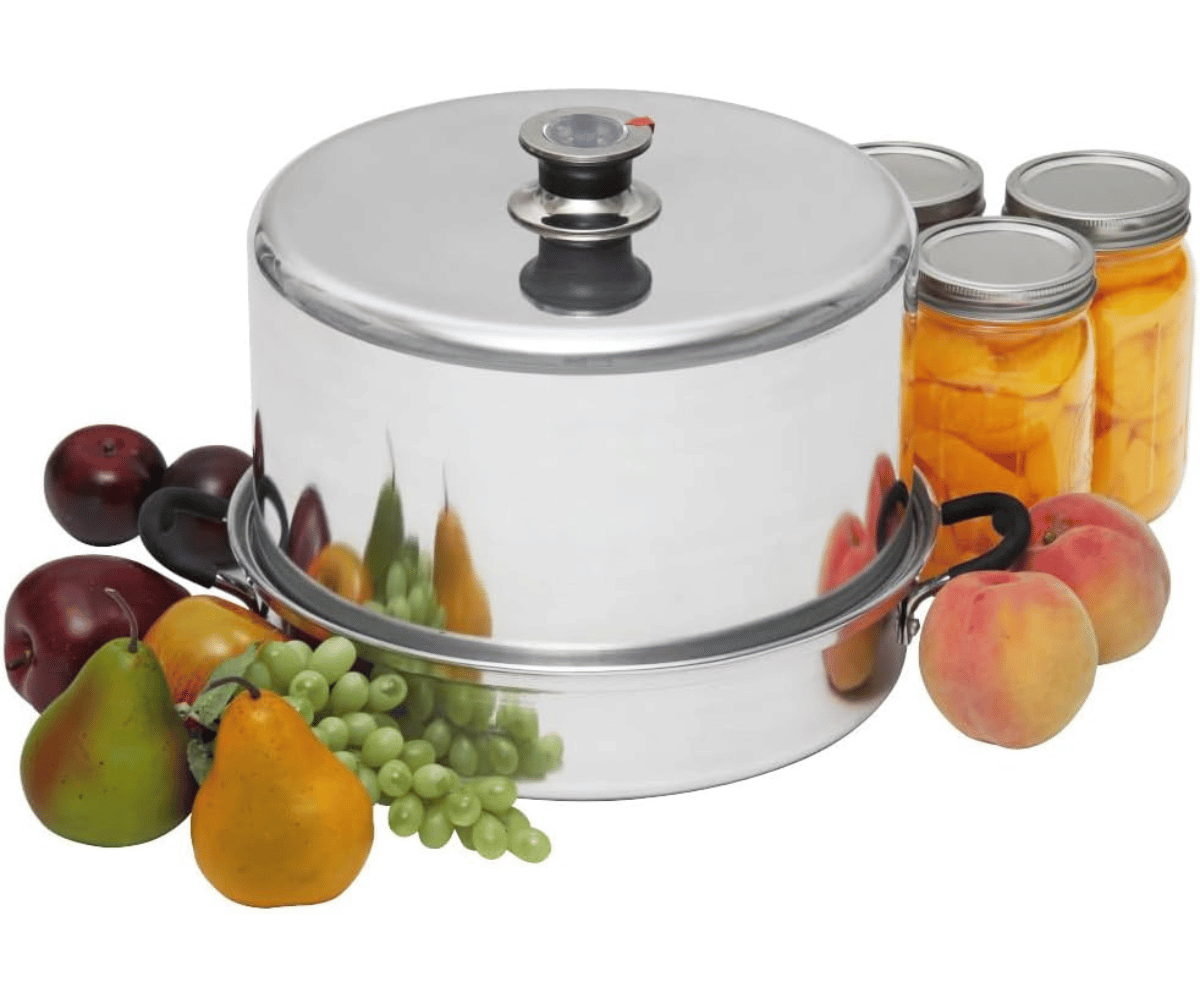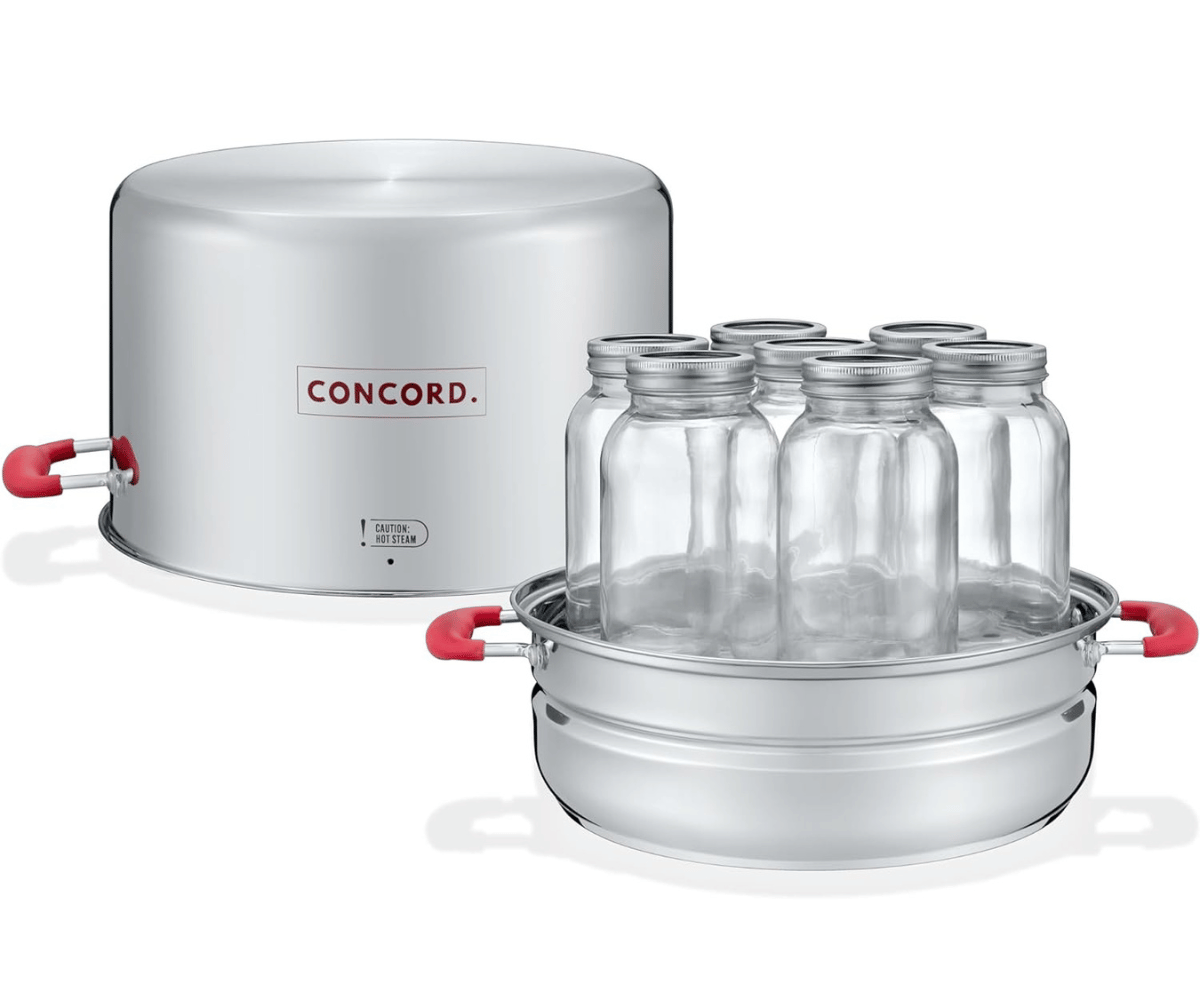Are you considering a steam canner to enhance your canning efficiency? With the right choice, you’ll enjoy faster heat-ups and effortless processing. Our guide cuts through the clutter, showcasing top steam canners tailored for different needs. Exploring durability, user-friendliness, and compatibility, we offer clear insights to help you find your kitchen’s new ally.
Quick Peek at Top Steam Canners
Steam canners are designed to use less water than traditional water bath canners, leading to faster heating times. As a result, they’ve become a favorite among home canning enthusiasts. But with so many options in the market, how do you choose the best steam canner for your kitchen? Let’s take a quick peek at some top-rated steam canners:
- Best Bang for your Buck: Kitchen Crop Aluminum Steam Canner
- Most Durable: Concord Stainless Steel Turbo Steam Canner
These steam canners have been chosen for their distinct features and benefits, catering to different user needs. Whether you’re just starting your canning journey or looking for a durable, multi-purpose kitchen tool, there’s a steam canner designed to meet your specific requirements.
Kitchen Crop Aluminum Steam Canner
Specifications:
- Material: Aluminum
- Capacity: 7-quart jars, or 8-pint jars
Pros:
- Simple to use, ideal for beginners
- Quick heating, efficient canning process with temperature indicator
- Small business
Cons:
- Not suitable for induction stovetops
If you’re new to the world of home food preservation and steam canning, the Kitchen Crop Aluminum Steam Canner is your perfect starting point. This steam canner’s features include:
- Ease of use, as reported by many users
- Quick heating and requires less water to boil, offering efficiency in the canning process
- Ideal for beginners, according to many users
- Simplicity combined with efficient and quick heating
This makes the Kitchen Crop Aluminum Steam Canner a great addition to any beginner’s kitchen.
Concord Stainless Steel Turbo Steam Canner
Specifications:
- Material: Stainless steel
- Capacity: 7-quart jars, or 8-pint jars
Pros:
- Durable stainless steel construction
- Can double as a stock pot
- Includes 7 jars
Cons:
- Higher price point
- Heavier than aluminum models
When durability tops your criteria for choosing a steam canner, the Concord Stainless Steel Turbo Steam Canner stands out. This steam canner features:
- Robust stainless steel construction, non-reactive, adding significant durability and utility, as it can also be used as a stock pot
- Large and deep water reservoir that protects against running dry, thereby preventing jar and canner damage, a common concern for durability in steam canning
- Induction compatible
- Improved silicone handles for better handling
Users have praised this Concord model for its durability, ease of use, and efficient heating.
Essential Features of Steam Canners
When choosing a steam canner, understanding its essential features is crucial to ensure it meets your needs. One of the fundamental characteristics of a steam canner is its design. A steam canner:
- Is a large capacity pot that is designed to trap and slowly release excess steam in a controlled way
- Is commonly used as a substitute for a water bath canner
- Consists of a shallow bottom, wire rack, and a domed lid with vent ports, which are key components that differentiate them from pressure canners
Another critical feature is the capacity of a steam canner. The size of the shallow base, which holds only a few inches of water, determines this. The small amount of water allows for a quick heat-up and efficient processing. Compatibility with various stove tops is also an important feature to consider. For instance, the Victorio Aluminum Multi-Use Canner VKP1145, with its aluminum build, is compatible with various stove tops, including induction, due to its material properties allowing effective heat transfer.
Understanding the Safety and Efficiency of Steam Canning
Steam canning is not only efficient but also safe when done correctly. Research indicates that steam canning is a safe preservation method for acid and acidified foods. However, it’s essential to note that steam canners should never be used for low-acid foods that require a pressure canner, such as:
- vegetables
- meats
- poultry
- fish
- seafood
- broth
- dried beans
Efficiency is one of the key advantages of atmospheric steam canning compared to traditional water bath canning. To use a steam canner, you only need around 2 quarts of water, allowing for quicker boiling and preheating periods. This makes steam canners suitable for processing naturally acidic or acidified foods in less time compared to water bath canning with a boiling water bath canner. The time and energy savings are significant with steam canning, providing benefits like faster heating and using less water while maintaining safety for high-acid tested recipes. Steam canners were also developed in the 1920s and have been validated for safe use by the University of Wisconsin-Madison when used correctly.
Making the Right Choice for Your Altitude
Altitude plays a crucial role in the canning process, which is why it’s important to consider when choosing a steam canner. As the altitude rises above 300 meters (1000 feet), the processing times in steam canning must be increased, with specific additional times required for preserving foods like jellies and jams. For each 5,000 feet of altitude, an extra minute should be added when blanching foods for canning.
Some steam canners, such as the Victorio Steam Canners, feature a temperature gauge with altitude-based indications to help users adjust processing times, although these are general indicators and not precise thermometers. Knowing the precise elevation of your canning location is crucial as altitudes can vary greatly even within the same area, which impacts how you adjust your canning process.
Summary
Steam canning offers a quicker, more efficient alternative to the traditional water bath canning method, making it a favorite among home canning enthusiasts. Whether you’re a beginner looking for a simple, easy-to-use steam canner or a seasoned canner in search of a durable and versatile kitchen tool, there’s a steam canner designed to meet your specific needs. With the right steam canner, you can take your home food preservation to the next level and enjoy the fruits of your labor all year round.
Frequently Asked Questions
What is steam canning?
Steam canning is a safe method of preserving produce using steam, especially for naturally acidic and acidified foods. It has been recently supported by research from the University of Wisconsin.
How do you use a steam canner?
To use a steam canner, place the rack in the bottom, fill with water just over the rack, and preheat the water. Then, place the jars in the canner, secure the lid, and process in pure steam at 210-212 degrees F for the recommended time. For raw-packed foods, the water in the canner base should be 140 °F, and for hot-packed foods, it should be 180 °F, then place the dome over the jars and turn the stove burner up until a full, steady column of steam appears.
Can you can tomatoes in a steam canner?
Yes, you can safely process tomatoes in a steam canner by adding citric acid to acidify them for safe canning. Using a steam canner with added citric acid makes it safe for canning tomatoes with a pH of 4.6 or below.
What can be canned in a steam canner?
You can safely can foods that are high in acid in a steam canner, including naturally acidic foods like apples, cherries, and peaches, and acidified foods like pickles and salsas.
Is a steam canner better than a water bath canner?
Yes, a steam canner is better than a water bath canner because it uses less water and speeds up the processing time. It also makes it easier to remove from the heat after processing.



